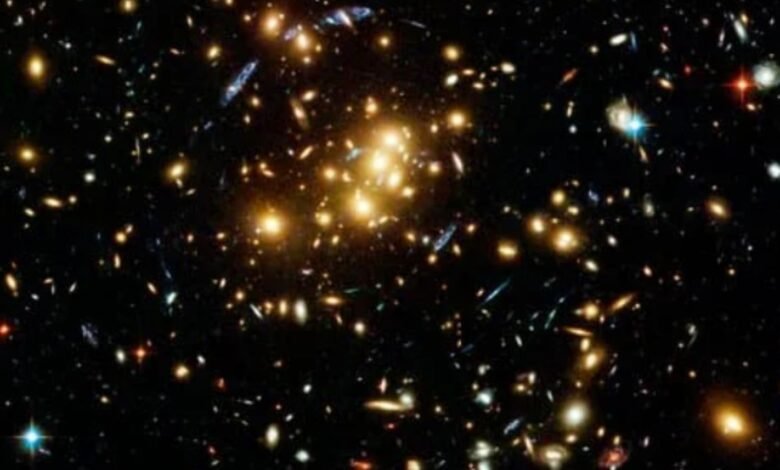Galaxy Observations Challenge Current Understanding of Dark Matter
An alternate explanation of gravity may be revealed by the latest study of the universe's light bends.

Perplexing Galaxy Observations are challenging conventional scientists’ conceptions of the cosmos, suggesting that dark matter, a strange material, may not exist.
According to recent study that was published in Astrophysical Journal Letters on June 20. According to Richard Brent Tully, Astronomer from University of Hawaii located at Manoa who was not involved in experiment, result “raises questions of an extraordinarily fundamental nature.”
Galaxy Observations Key Points:
- Study in Astrophysical Journal Letters
- Fundamental Questions Raised
- Dark Matter and Galaxy Rotation
- Gravitational Lensing and Galaxy Contents
- Tobias Mistele’s Research Findings
- Gravitational Lensing in 130,000 Galaxies
- Stars Rotating Too Quickly
- Invisible Material in Galaxies Questioned
- MOND: An Alternative Theory
- Dark Matter vs. MOND Debate
- Bhuvnesh Jain on Dark Matter
- Future Data from Euclid Satellite
- Solving the Cosmic Mystery
Because of the rotation of stars and other visible material near a galaxy’s visible edge, astronomers believe dark matter exists. Given amount of bright material viewed through telescopes and rotational speeds of objects far from a galactic center are significantly higher than they should be. Our current understanding of gravity, those stars must be being pulled by a tremendous reservoir of invisible stuff.
New findings are predicated on idea that big things change space and time. Theoretically, galaxies are composed of a massive halo of invisible dark matter in addition to vast amounts of gas, dust, and visible stars. This implies that light will experience gravitational lensing, or bending and changing of light as it passes through a galaxy.
As a means of exploring contents of galaxies, astronomer Tobias Mistele of Case Western Reserve University in Cleveland and associates made decision to look for indications of gravitational lensing around a number of galaxies. In order to find telltale streaks that suggested existence of more distant galaxies whose light had been bent and altered by intervening objects, team examined a catalog containing roughly 130,000 galaxies imaged by VLT Survey Telescope located at European Southern Observatory’s Paranal Observatory in Chile.
The degree of lensing offers a surrogate measure of the foreground galaxies’ masses, encompassing both their luminous matter and, most likely, the significantly greater amount of dark matter around each galaxy. Next, using the mass at different distances from the center of each galaxy, the scientists determined the orbital velocity of a star at those distances.
According to the dominant cosmological model, known as Lambda CDM, dark matter congregates into massive globs in space, and these globs’ gravitational pull on visible matter eventually forms galaxies (SN: 4/4/24). These halo-like clusters can be found at least 300,000 light-years from a galaxy’s center, according to earlier measurements. Star rotation rates should begin to decrease after that point.
However, Mistele and his colleagues determined, using their gravitational lensing data, that given the presence of both visible and dark matter thought to exist in the galaxy, a star positioned a million light-years from the center of each galaxy and possibly as far away as 3 billion light-years would still be rotating far too quickly.
Does that suggest amount of invisible material is higher than previously believed? Maybe not.
Modified Newtonian dynamics, or MOND, is a competing hypothesis to Lambda CDM that proposes a different behavior of gravity on galaxy scale, doing away with idea of dark matter completely (SN: 3/28/18). MOND, which has long been supported by Mistele’s colleague Stacy McGaugh, who is also at Case Western, precisely forecasts the kinds of observations that are noted in the research.
However, Lambda CDM isn’t out of the game just yet.
Bhuvnesh Jain (a cosmologist at the University of Pennsylvania) says, “I think it’s a real stretch to say that one can do away with dark matter, because the lines of evidence [for it] are so numerous.”
For example, Lambda CDM provides a significantly better explanation for the expansion of large-scale structures in the cosmos since the Big Bang than does MOND. Inspired by the higher-dimensional thinking found in string theory, Jain speculates that even more exotic concepts in mathematical models of gravity might be able to explain the universe’s existing large-scale structure. Some variants of these theories could both explain the results of Mistele and his colleagues and change the significance of dark matter.
Researchers may soon have access to considerably better gravitational lensing data thanks to observations made by the European Space Agency’s Euclid satellite, which appeared last year. This information may help solve this peculiar puzzle.
- Asteroid Threat: ISRO Chief Warns Of Real Possibility, Calls For Global Preparedness
- ‘358 Days on the Red Planet’ Mission
- Lunar Swirl Secrets: Hidden Moon Feature Explained by Volcanic Past?
Conclusion
Conventional cosmological ideas have been challenged by a new study raising fundamental doubts regarding existence of dark matter. Although dark matter has long been thought to be present in order to explain why stars in galaxies rotate so quickly. Recent findings raise possibility that this enigmatic material does not actually exist. Study headed by Tobias Mistele and his team, examined contents of galaxies using gravitational lensing data and found differences in star rotation speeds that are not entirely explained by existing models.
Other theories, such as Modified Newtonian Dynamics (MOND), provide an alternative interpretation of gravity and could explain similar results without referring to dark matter. But the well-supported dominant Lambda CDM model is still a leading candidate to explain the large-scale structure of the cosmos.




Your article helped me a lot, is there any more related content? Thanks!